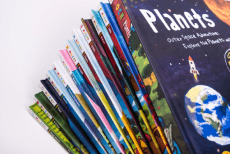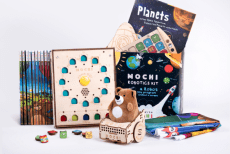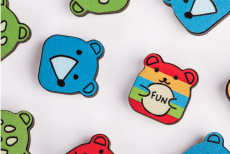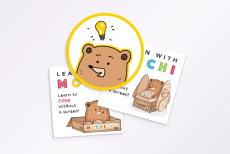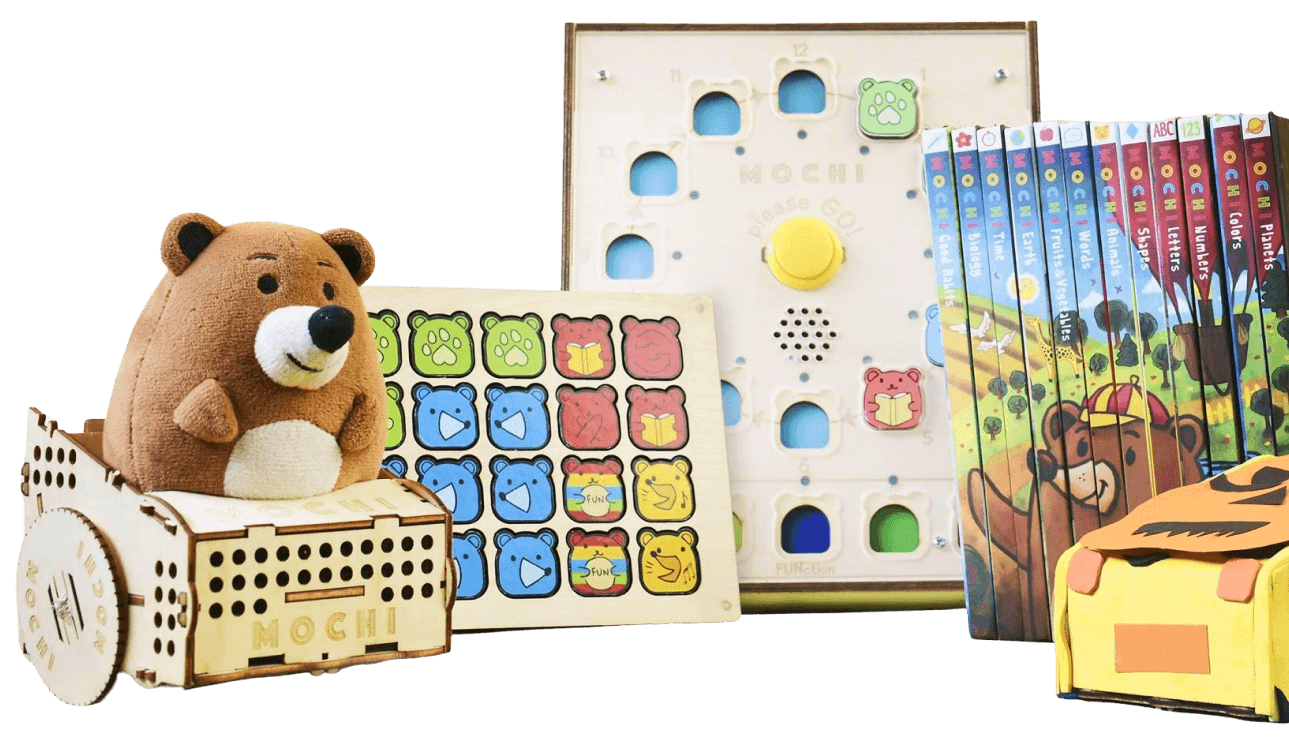
Maria Montessori once said, ‘Imagination does not become great until human beings, given the courage and the strength, use it to create.’
If you’re familiar with Mochi you might be aware that we’re somewhat Montessori devotees. Her hands-on learning principles run through everything we do. After all, learning and play shouldn’t be mutually exclusive. That’s how we feel when it comes to engaging with technology, too. It shouldn’t just be for consuming, but for creating.
In case you weren’t aware, this media and technology lark it isn’t a fad – it’s here to stay. In today’s world, many kids start consuming technology from an early age. Studies have shown that nearly 97 percent of children under 4 have used mobile devices, and most started using them before the age of one. By age 4, half of the children have their television, and three-quarters have their mobile.
But engaging with gadgets doesn’t have to be a passive exercise. There’s an important difference between consuming with technology and creating with it. Learning toys can give kids the power to be adventurous and imaginative, and urge them to become creators.

iStock/half-point
Room to consume
So what is the difference, we hear you ask? Well, let’s start with what consuming with technology means.
It may sound obvious, but ‘consuming’ means just that. Being absorbed by technology without producing much as a result. As any parent who has a child hooked on a particular video game or app will tell you, time-consuming can be part of that, too.
But there are several different types of consuming with technology, says college professor and former middle school teacher John Spencer. You can passively be exposed to something, he says on his blog – a TV on in the background, say. Or actively seek something out – like searching for a favorite YouTube video. Then there’s what Spencer calls ‘Critical Consumption’ – when you begin to become an expert and can appreciate the nuances in what you are consuming.
Although the word ‘consume’ has negative connotations, Spencer argues that it can lead to creativity; that through consuming comes curation, copying, adapting, and then ultimately creating.
This is far from an exact science, of course. In many cases, some steps are jumped and a child can go straight from passive consuming to copying, for example. But when used appropriately, technology – especially education toys and toddler learning systems – can help move through those steps and spur creativity.
Why create?
It’s estimated that 65 percent of children heading into primary school today will end up working in a job that doesn’t even exist yet. And that’s looking into the future. Even today, many of the most in-demand jobs didn’t exist five or ten years ago.
Technology isn’t going anywhere. So it makes sense to embrace it and use it to create and innovate rather than just for passive consumption. There’s value in accomplishment, and that’s as valid in the digital world as in any tangible environment.

Why aren’t many children creating with technology?
Studies show that most children under 8 are consumers of technology and not creators. This report from the European Commission Joint Research Centre states that lack of access to suitable devices is a contributing factor and that parents worry about the number of times children might spend in a virtual world.
But that doesn’t have to be the case.
Learning devices for kids can help children not only engage meaningfully with technology but be active creators of it.
‘The active, appropriate use of technology and media can support and extend traditional materials invaluable ways,’ says a joint statement by the National Association for the Education of Young Children and the Fred Rogers Center for Early Learning and Children’s Media (try saying that five times fast).
The report by the NAEYC and Fred Rogers Center (much easier) goes on to say that ‘research points to the positive effects of technology in children’s learning and development, both cognitive and social’.
Play is central to this. Kids need to be able to explore technology in playful and creative ways. And if, as part of that, they can pretend how a particular task might translate to real life? All the better.
Cubetto, for example, helps young kids learn coding without a screen and through hands-on play. Children are learning digital skills through a toy that’s designed for them and not an adult.
Through educational toys, parents and families can use technology to ask questions and share information with children, encourage their creativity, and have fun together.

Mine-craftiness
There are many games, apps, and toys out there that are helping to foster curiosity and imagination.
Take open-ended sandbox games like Minecraft, for example. There are seemingly endless possibilities for what children can build using geometric shapes in this hugely popular video game. It requires thinking and reasoning, strategy, and spatial awareness.
In the same way that children find a whole world of possibilities when playing in the tangible world, they can too in digital space through Minecraft. The game has been referred to as a positive toy for creativity and self-expression.
Research suggests that the game can help children with problem-solving, design, and engagement. The goal? To share your innovations, showcase your creativity, and collaborate with fellow players. Just like tangible play.

Smart art
And it isn’t just console or PC games that can feed creativity. The imaginative possibilities that apps can bring are seemingly infinite. The user-friendly, largely-buttonless set-up of smartphones and tablets makes them hugely versatile for app developers, and they’re quickly becoming toddler learning systems in themselves.
Art apps are just one way to use an iPad or phone creatively. And creating art on a screen means there’s no mess to clear up (apart from some grubby finger stains, perhaps).
Apps like Art My Kid Made and Sago Mini Doodlecast are just two popular apps that children and parents both love. ‘Art My Kid Made’ backs up every doodle or drawing created to Dropbox or Evernote so nothing is ever thrown away (there’s a finite amount of room on a fridge door, after all). With Sago Mini Doodlecast, kids can record their voices as they sketch and the app records the entire drawing process so, afterward, they can watch a video of their drawing coming to life, complete with every giggle through the process.

Musical maestros
And speaking of audio recording, musical apps can feed creativity, too. With ‘Loopimal’, instead of conventional musical instruments, animals are making all the noises. But behind the silly graphics and bright colors, the app teaches kids how to use an audio sequencer, as they drag and drop shapes on to a timeline to make music.
‘Easy Music’ – featuring a very friendly bear host – introduces children to musicality, helping them recognize notes, pitch, and rhythm. Once the basics are learned, it’s time to get creative by composing pieces themselves, at their own pace. They learn about melody and then produce their music.
Screen test
Of course, the worry with apps and smartphones is that too much gazing at a screen can cause children harm. Indeed, some studies say that too much screen exposure can affect concentration and behavior in children. The American Association of Pediatrics has useful recommendations on this, including limiting screen use to one hour per day for ages two to five.
But there’s also an argument that it’s the content on the screen, rather than the screen itself, that’s most important. Dr. Dimitri Christakis – director of the Centre for Child Health, Behavior and Development at the Seattle Children’s Research Institute – says a blanket ban on screens doesn’t make sense. ‘Screens are purely a delivery mechanism,’ he explains on the GetPocket blog. ‘What parents should be focused on is the content.’
There’s a big difference between passively watching TV and actively engaging with an iPad, he continues, while Heather Kirkorian – an assistant professor in developmental psychology at the University of Wisconsin – agrees. She used two different methods to teach two groups of children new words: one group through watching a video, the other through touching a screen to create an outcome. ‘For kids under 30 months old, they learned more when there was an interactive component,’ she concluded. ‘I think that shows the potential touchscreen devices might have as educational tools, especially when compared to television.’

iStock/maximkabb
Seven great ways to help kids use technology to become more creative
So what can we adults do to help children create and not just consume? The HighScope Educational Research Foundation offers many useful suggestions for using technology with young children.
1. Be careful
It sounds obvious, right? Whatever form of technology a child engages with, it’s important to make sure that it’s not going to hurt them or the equipment itself could be damaged. Neither a trip to the emergency room nor a phone call to an insurance company is a fun way to spend an evening.
2. Choose child-friendly technology
Technology is getting increasingly easy for children to use. But while they might know how to use different pieces of tech, devices that have a kid’s capabilities in mind will be more rewarding.
Mochi tools are designed for small hands, for example. They’re intuitive, not complex, and can be played with the instant you take him out of the box.
3. Mix the tangible and virtual worlds
Interacting with other people and materials is vital for early learning. It’s also important to become familiar with technology, but it should not replace hands-on learning with tangible objects. Marry the two.
4. Encourage children to share, collaborate and help each other
If a child already knows how to use a toy or gadget, they should be encouraged to help their friends learn how to use it too.
By collaborating and sharing, kids learn from their mistakes, rather than being stifled by fear of failure. After all, every idea is a good one. Rather than shy away from it, technology should be used to encourage social interaction.
5. Adults should collaborate, too
Remember, you’re not there just to supervise, you’re their partner. Buddy up with your child and help them to be their most creative.
6. Choose the right programs and applications
When using technology, the emphasis should be on interactivity and open-ended learning, rather than set tasks with simple right and wrong answers. It should encourage discovery and be about the journey itself, rather than just the outcome.
7. Creating with technology shouldn’t be silent
Children should be encouraged to talk about their problems and the thinking that’s required to solve them. If they’ve tried to find a solution but not figured out what works, acknowledge their effort and help them find the resolution without simply doing it for them. As we say, it’s about the journey, so they might as well have fun getting there.

